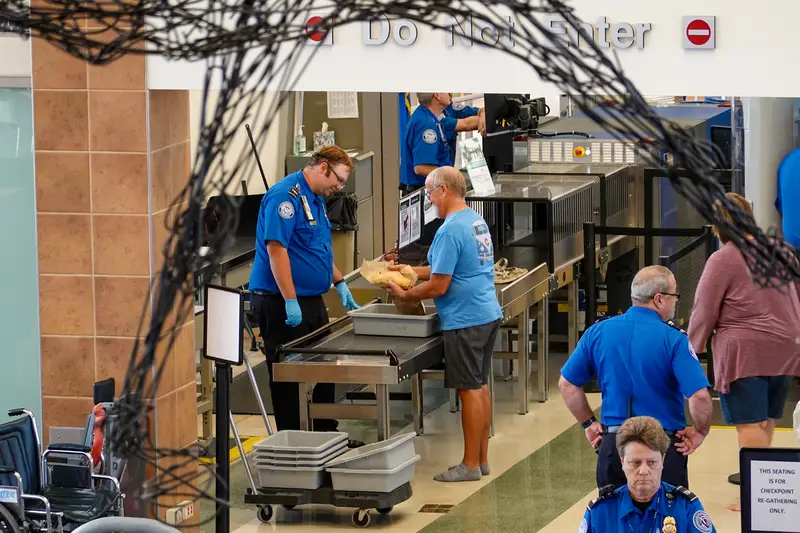After twenty years of forcing millions of travelers to remove their shoes at airport security checkpoints, the TSA quietly ended this widely mocked policy in 2025. The shoe removal rule, implemented in 2006 following Richard Reid’s failed “shoe bomb” attempt in 2001, never caught a single terrorist but consumed an estimated 30,000 years of collective human time. This pattern of implementing pointless security measures that stick around for decades reveals a troubling truth about how airport security really works in America.
The shoe removal rule existed for two decades without results
Richard Reid’s botched shoe bomb attempt on December 22, 2001, should have been a footnote in aviation history. The British-born terrorist boarded American Airlines Flight 63 from Paris to Miami with explosives hidden in his sneakers, but his plan failed spectacularly. Flight attendants noticed him lighting matches and tackled him before he could detonate anything. Passengers and crew members subdued Reid, with an off-duty doctor even tranquilizing him for the remainder of the flight.
Despite this single failed attempt, the TSA waited five years before implementing the shoe removal policy in August 2006. During those intervening years, no similar incidents occurred, and none have happened since. The agency never caught anyone with bombs hidden in their shoes, making this one of the most pointless security measures ever devised. Aviation security experts questioned its necessity from the beginning, noting that other countries with sophisticated security systems never adopted similar policies.
Most countries never bothered copying America’s shoe obsession
International travelers have long noticed that shoe removal requirements exist almost exclusively in the United States. Airports in Israel, known for having some of the world’s most stringent security measures, never required passengers to remove their footwear. The same goes for major European hubs like Amsterdam’s Schiphol and London’s Heathrow. These airports handle millions of passengers annually without forcing them through the humiliating ritual of showing their socks to security personnel.
MIT aviation security expert Yossi Sheffi, who was born in Israel, summed up the absurdity perfectly in 2011: “You don’t take your shoes off anywhere but in the U.S.—not in Israel, in Amsterdam, in London. We all know why we do it here, but this seems to be a make-everybody-feel-good thing rather than a necessity.” The fact that security-conscious nations worldwide ignored the American approach should have been a massive red flag that this policy served no legitimate security purpose.
TSA officials used circular logic to defend the useless policy
When pressed to justify the shoe removal requirement, TSA officials resorted to laughably circular reasoning. John Pistole, former head of the TSA, argued that the policy worked because no shoe bomb attacks had occurred since implementation. “We have had over 5.5 billion people travel since Richard Reid, and there have been no shoe bombs because we have people take their shoes off,” he claimed with apparent seriousness.
This logic mirrors the classic joke from Sesame Street where Ernie claims his banana keeps alligators away from the street. When Bert points out there are no alligators, Ernie declares his banana is doing an excellent job. The TSA’s reasoning suffered from the same fundamental flaw—assuming that the absence of shoe bomb attempts proved the policy’s effectiveness, rather than considering that shoe bombs were never a realistic threat to begin with. Survey data showed shoe removal ranked second only to high ticket prices in passenger complaints, yet officials clung to their circular justification.
The liquid restrictions created similar pointless theater
The infamous 3-1-1 liquid rule emerged from a 2006 plot to use liquid explosives on transatlantic flights. Suddenly, passengers couldn’t bring normal-sized bottles of shampoo or toothpaste through security. The rule requires all liquids to fit in containers of 3.4 ounces or less, packed in a single quart-sized bag. Security experts have long pointed out that if liquid explosives were truly dangerous, combining multiple small containers would pose the same risk as one large container.
The arbitrary nature of these restrictions becomes obvious when considering that multiple small bottles of the same liquid somehow become safe, while one large bottle remains dangerous. Passengers routinely game the system by bringing multiple 3.4-ounce containers of the same product, exposing the rule’s fundamental absurdity. Like the shoe policy, liquid restrictions persist not because they enhance security, but because removing them would require admitting they were never necessary in the first place.
Post-incident rules often target the wrong problems entirely
The TSA’s response to the 2009 “underwear bomber” incident revealed how reactive and illogical their security measures truly are. After Umar Farouk Abdulmutallab attempted to detonate explosives hidden in his underwear on a Christmas Day flight, the agency implemented bizarre new restrictions. Passengers couldn’t move during the final hour of international flights, couldn’t have anything on their laps, and airlines had to disable moving map displays showing the aircraft’s location.
These rules made no logical sense since Abdulmutallab was sitting in his seat when he attempted the attack, and knowing the plane’s location wouldn’t have changed anything. The restrictions lasted only days before being quietly abandoned, highlighting how the TSA makes knee-jerk reactions without considering whether new policies address actual security concerns. The incident also exposed a more fundamental problem—Abdulmutallab’s father had warned the U.S. Embassy in Nigeria about his son’s radicalization, yet this clear security threat still managed to board the aircraft.
PreCheck members got special treatment for the same activities
The TSA PreCheck program, launched in 2011, exposed the arbitrary nature of many security rules by allowing pre-approved travelers to skip them entirely. PreCheck members could keep their shoes on, leave laptops in bags, and carry normal-sized liquids. If these activities truly posed security risks, why would paying a fee and undergoing a background check make them safe? The program essentially created a two-tiered system where the same actions were simultaneously dangerous and harmless depending on membership status.
This contradiction revealed that many TSA rules existed primarily to inconvenience passengers rather than enhance security. PreCheck members weren’t superhuman or incapable of criminal activity—they simply paid for the privilege of being treated like reasonable adults. The program’s existence inadvertently proved that standard security theater was largely unnecessary, since millions of PreCheck travelers safely bypassed these supposedly critical safety measures without incident.
Technology excuses masked the real reasons for policy changes
When the TSA finally eliminated the shoe removal requirement in 2025, officials cited “cutting-edge technological advancements” as the reason for the change. Homeland Security Secretary Kristi Noem claimed that new screening technology and multi-layered security approaches made the policy unnecessary. However, these technological solutions had been available for years, and the “multi-layered approach” had been in place since the rule’s inception.
The real reason for the policy change was mounting political pressure and public criticism, not technological breakthroughs. Reports of electromagnetic shoe scanners had circulated for over a decade, with promises of implementation always pushed to future dates. By invoking technology as the justification, officials avoided admitting the uncomfortable truth that the shoe rule had been pointless from the beginning. This pattern of using technological progress as cover for policy reversals allows agencies to save face while quietly abandoning failed programs.
Security theater persists because admitting mistakes looks weak
The shoe removal policy’s two-decade lifespan illustrates why ineffective security measures become permanent fixtures. Once implemented, these rules create a ratchet effect where removing them appears to compromise public safety, regardless of their actual effectiveness. Politicians and bureaucrats fear being blamed for future incidents if they eliminate existing policies, even when those policies serve no legitimate security purpose.
This dynamic creates perverse incentives where officials prefer maintaining useless but visible security measures over implementing effective but less noticeable improvements. The TSA’s reluctance to admit the shoe rule’s futility reflects broader institutional problems where appearing tough on security matters more than actually improving safety. George Mason University economist Bryan Caplan calculated that the shoe policy consumed almost 30,000 years of collective human time, making Richard Reid arguably the most successful anti-American terrorist despite his complete failure to detonate any explosives.
Real security failures get ignored while theater continues
While passengers endured decades of shoe removal requirements, genuine security vulnerabilities remained unaddressed. The TSA’s own internal testing consistently revealed that screeners failed to detect prohibited items at alarming rates. Undercover investigators regularly smuggled weapons and explosives through checkpoints, exposing the system’s fundamental inadequacies. Yet instead of fixing these core problems, the agency focused on expanding security theater that created the illusion of safety without substance.
The Abdulmutallab case perfectly exemplified this misplaced emphasis—a known security threat with documented warnings from his own father managed to board an aircraft, yet the TSA’s response targeted innocent passengers’ freedom of movement rather than intelligence sharing failures. This pattern repeats across multiple incidents where systemic problems get ignored in favor of new restrictions that penalize law-abiding travelers while doing nothing to address actual security gaps. The focus on visible enforcement over effective protection has created a system that excels at inconveniencing the public while failing at its primary mission.
The end of the shoe removal requirement after twenty years proves that many TSA policies exist primarily as security theater rather than genuine safety measures. When agencies can quietly abandon long-standing rules without explanation or admission of error, it raises serious questions about which current policies serve actual security purposes versus those designed to create the appearance of vigilance. Travelers deserve honest assessments of security measures rather than elaborate performances that waste time and resources while providing minimal protection.

